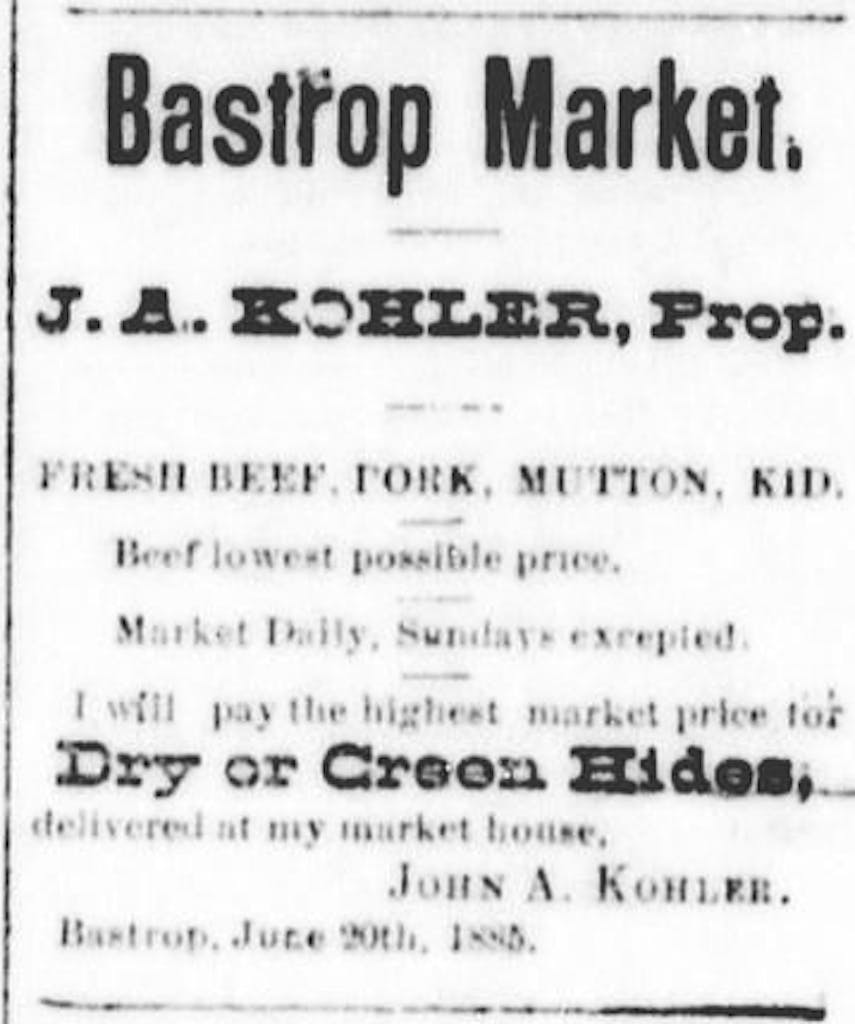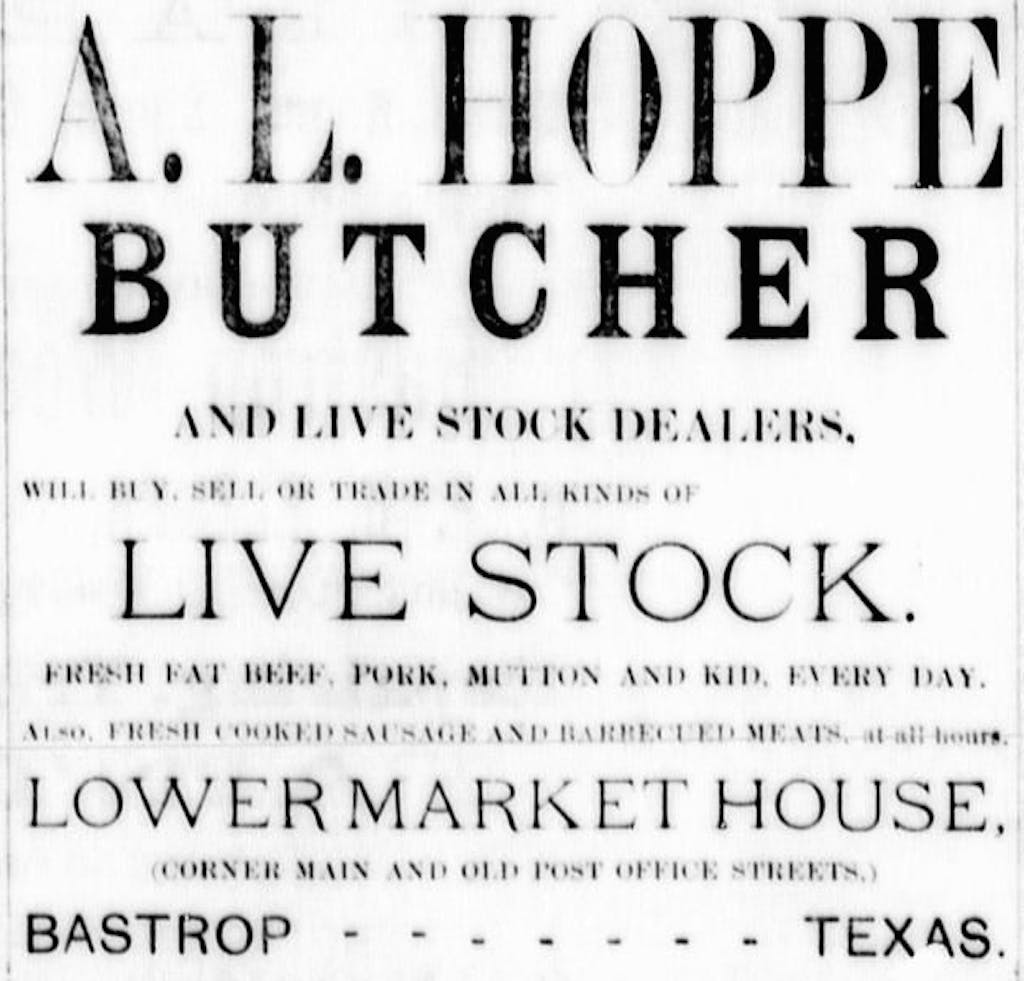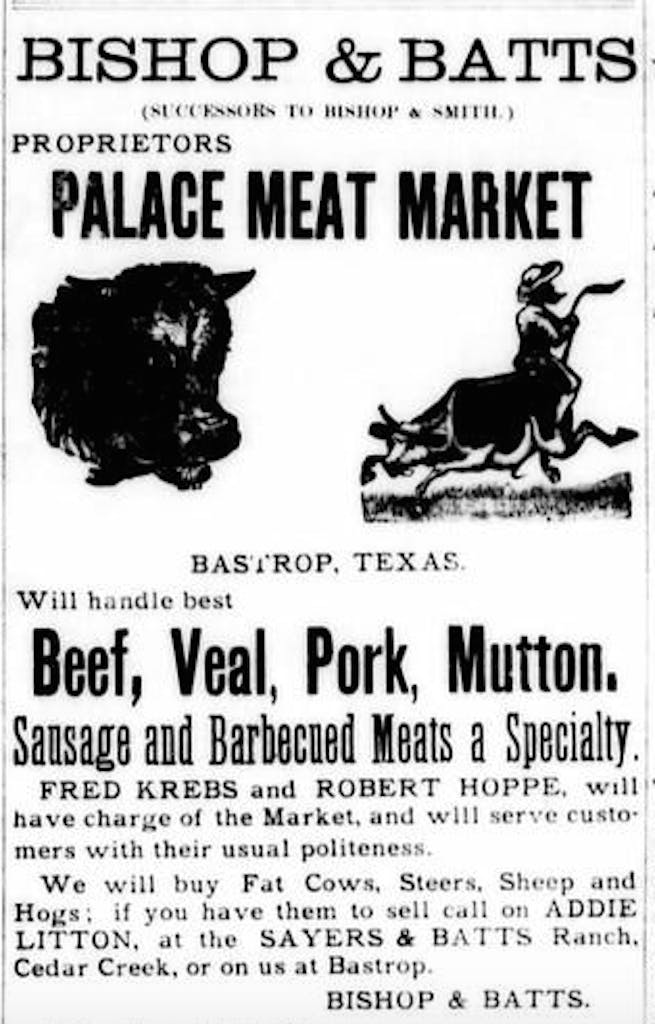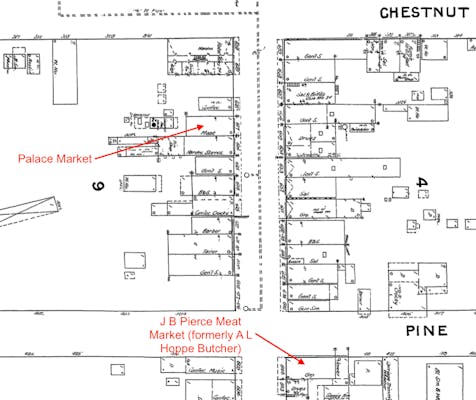For years, I’ve been on a quest to definitively answer a question that has plagued me since I began researching the history of barbecue: what was the first barbecue joint in Texas?
Loyal readers of TMBBQ will remember that in August 2013, I wrote about the post-Civil War wave of butcher shops and the resulting first boom of commercial barbecue. As I noted then:
The first mention of commercial smoked meat in [the University of North Texas’s collection of old Texas newspapers] is from the October 25, 1878, edition of the Brenham Weekly Banner: “A Bastrop butcher keeps on hand at his stall a ready stock of barbecued meats and cooked sausages.” There is no other context given about the location or the proprietor, but it’s certainly a butcher in Central Texas. It may have been one of the two rival butchers in Bastrop that began advertising barbecued meats eight years later. In August of 1886 it was Bastrop’s Alexander & Gill who were promoting barbecued meats at their new market. Two months later John Kohler ran a similar ad.
This mysterious ad left my curiosity piqued, and since I published that column, I’ve returned occasionally to research both Alexander & Gill and John Kohler to determine which of these places opened first.
First, a bit about the former. The Gill brothers—Thomas, Robert, and Peter—were sons of a Bastrop sheriff and all three served in the Civil War. Thomas A. Gill, who also served with the famous Eighth Texas Calvary (known colloquially as Terry’s Texas Rangers, a brigade honored with a memorial on the Capitol grounds), was a butcher by trade, and that is the profession he fell back to after the war. But around 1867, Thomas left for California with his wife and new son, and Robert took over his brother’s butcher shop. Robert was listed as a butcher in the 1870 census, and his brother Peter was a cattle dealer, or “stockmen” according to information from the same census. Robert’s request for “good, fat beeves” was published in 1871 in The Bastrop Advertiser, and from the same paper in 1875 we know Robert and Peter paired up their businesses—it certainly makes sense for a cattle man and a butcher to work together—and opened a store referred to as the “market house” on March 13 of that year. It sat “on the corner fronting J. C. Buchanan & Co.’s store.” From studying old Sanborn maps and newspaper articles, I’d wager that this store was on the northeast corner of Main and Chestnut (shown as “Gen’l M’d’se” on the 1895 Sanborn map below).

There’s also a very good chance the brothers were cooking the very barbecue mentioned in that 1878 clipping. The squishiness of this fact stems from an important gap in information. Archives of The Bastrop Advertiser are no help since the (albeit invaluable) newspaper records housed by UNT are missing issues of the paper between February 1876 and early January 1879. Still, in the 1870 census, Robert Gill and Ken Hinsler, Robert’s Swiss-immigrant employee, are the only butchers listed.
In the 1880 census, Robert was listed as a “merchant,” because, as recorded in the archives of the Advertiser, by February 1879 Robert had moved on to his clothing store. Peter was still listed as a cattle dealer. In another census record, called the “Census of Manufacturers,” Peter Gill’s slaughtering operation is noted, along with the 364 head of cattle and 20 hogs he processed in the previous year. Another butcher shop is listed as well. This one was Osborn & Cartwright operated by the father and son-in-law team of Tom Osborn and Charles Cartwright. There is no record of when their store opened, but Neither were listed in the 1870 Bastrop census. They would later sell their market and go on to operate the Iron Front Restaurant serving “Oysters, fish, and all the deep sea luxuries.”
I admit this is a limb to go out on (I have yet to address John Kohler), but I’m going to tip-toe out to an even thinner branch by saying I believe it was Peter Gill who was the pitmaster in charge. In 1880, Peter Gill was lauded for slaughtering a whopper of a steer (1,495 pounds), and was the sole owner of the butcher shop as noted in the 1880 Census of Manufacturers. In 1896, Peter would be credited for overseeing a Fourth of July barbecue, during which he, “assisted by Ed. W. Jenkins and several colored men” barbecued “fifty-seven carcasses of beef, pork, mutton and kid.” The-African American men who helped were given no credit, so there could be a chance that Peter wasn’t actually doing the smoking, even at Gill’s original market, but it seems Peter was known more for his barbecue prowess than his brother Robert.
Now, about John Kohler. His butcher shop is featured in an 1886 advertisement in the paper.

Kohler got into the butcher business in 1883 when he bought a meat market from Osborn & Cartwright (remember them?). Per his advertisements, it appears he didn’t begin serving barbecue until three years later, and I’ve found no previous or later mention of Osborn or Cartwright being connected to barbecue. In 1886, Kohler ran a humorous advertisement highlighting the tenderness of his barbecue. It read:
‘Hello, Bob! Where did you get that big chunk of barbecued meat?’
‘Yonder, at Kohler’s market, and you bet it’s tender, too. ‘Old Whistler’ knows how to cook, and don’t you forget it.’
We never learn the cook’s real name. But it would seem that Kohler brought Old Whistler on to compete with a rival business called the New Meat Market. It was started by T. C. Alexander in June 1886, and soon after he partnered with Peter Gill (fresh from a thresher accident that mangled his right hand). Once Alexander brought Gill on, they began to advertise their “Barbecued Meats” of beef, mutton, and pork. Evidently early risers, the menu was available from 4 a.m. on, and Sundays too.

Kohler jumped onto the barbecue bandwagon once Alexander & Gill announced their plans, and from there it was a barbecue free-for-all in Bastrop. The sheer number of pre-1900 advertisements for barbecue in a town that had a population of 1,634 is staggering. From 1886 on there were at least two markets competing with one another. A. L. Hoppe opened on the southeast corner of Main and Pine in 1889, serving “fresh cooked sausage and barbecued meat.” The Palace Market, located further up on Main, started advertising in 1891 for “sausage and barbecued meats a specialty.”


In hindsight, it was really the Palace Meat Market that started me on my dive into the rabbit-hole of newspaper archives, census records, and Sanborn maps. A structure labeled “Barbecue” and another labeled “Sausage Fac.” behind a meat market in the 1891 Sanborn map of Bastrop got me thinking that I might be able to nail down that mystery “Bastrop butcher.”

After much digging, I found that that structure was built in February 1891 by Tom Bishop to house his Palace Market. Expansion continued into the twentieth century with several new owners along the way. The building that now stands at 922 Main Street in Bastrop is on that site, but I’m not sure when that building was erected. The barbecue pits and the smoke-house are probably gone for good.


In any case, Bastrop’s early, nineteenth-century obsession with barbecue was just the beginning. The City Market of Schneider & McDow offered barbecue meats in 1892. In 1897 the Schaefer Market served barbecue and even calf head barbacoa. A year later Peter Gill passed away of malarial fever, probably not knowing what he had started. Gill, along with many others helped make Bastrop a cradle for the meat market style of barbecue we still enjoy in Texas. He might even have been the first.








